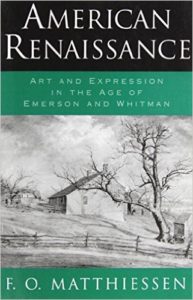Most scholars of American literary studies are likely to pinpoint the NEW CRITICISM as the most predominant postwar methodology associated with American literary criticism; however, questions and debates about the New Criticism’s objectives and scopes of study raged for decades, and varying perspectives led to alternate philosophies in regard to determining a consistent definition for what the New Criticism entailed. Even as late as the 1950s, there was still a widespread agreement in America that literary criticism and history should merge (Graff 210). This consensus was primarily due to the fact that American literature had been so deeply entwined with political, revolutionary, and religious writings since the inception of Colonial America. However, as Thomas P. Miller writes, “The New Criticism was instrumental in distancing literary studies from the more politically engaged schools of criticism that were popular in the Progressive era” (162).
For a majority of scholars associated with the New Criticism, the separation of history and literature was essential, for many critics felt that the “study of literature means the study of literature, not of biography, not of literary history…or anything except the works themselves, viewed as their creators wrote them, viewed as art, as transcripts of humanity” (Miller 139). Nevertheless, completely separating history from literature was not part of the process for all scholars of the New Criticism. According to Graff, theorists like Winters, Maule, and Matthiessen applied the methods of the New Criticism to American literature, allowing the New Criticism to become a cultural and historical method” (217). These critics sought to turn the New Criticism into a method of cultural analysis where they charted continuity found in literary traditions and allegorical meanings in writings from the Puritans, Transcendentalists, and Romantics (Graff 217).

However subtle, the connection to history still played a role in the study of literature, and this played a major role in making American literature exclusive from other literatures. Eventually, other advocates of the New Criticism began to question this style of literary study. Some critics argued that this mode of New Criticism purposely ignored American literary texts from the Revolutionary Era and non-symbolic texts that did not conform to its presuppositions (Graff 221). Debates such as these inspired new methods of criticism, most importantly, the NEW HISTORICIST perspective that offered “a revisionary reinterpretation of American literary history” (Graff 221). This change led to myriad other American literary modes of scholarship. As Robert P. Yagelski writes in “English Education,” a chapter from English Studies: An Introduction to the Discipline(s), objectivist principles associated with the New Criticism gradually shifted to principles associated with language and epistemological relativism of postmodernism, which opened up previously marginalized and ignored literatures that promoted cultural critique while challenging the literary canon (McComiskey 303).
One such cultural study that has grown extensively over the last two decades, thanks in part to the New Historicist perspective, has been the field of NATIVE AMERICAN STUDIES. However, scholars in this field of study also debate about what constitutes Native American studies, the perspectives from which its texts are written, and are even embroiled in arguments about who should be allowed to publish scholarship in the field. As most studies suggest, “The literatures that American Indian authors produce disrupt and resist the narrative strategies of colonial imaginings…” (Nelson 381). Nevertheless, despite this credence among most scholars, a newer shift in the paradigm of Native American studies is occurring, leading to a variety of related questions. Although NATIONALISM, where the focus centers on producing literary criticism that supports Native sovereignty, used to be the dominant critical form of study, a shift in critical focus to the “Native intellectual, cultural, political, historical, and tribal national contexts” is at the forefront of the new wave of study (Nelson 379). One prime reason for this shift in study is that the nationalism approach promoted an expansively broad range of study, often crossing over into all Indigenous studies, ethnic studies, and race studies, instead of just Native American studies (Nelson 383).
If that doesn’t muddy the water enough, the Indigenous literatures present further problems regarding their study. “No distinction is even attempted between migrant literatures and Indigenous literatures. But this distinction is, in fact, the elephant in the room that no one wants to address in discussions of how Native American literature should be presented (Madsen 357). As Madsen denotes, the haziness surrounding Native American literature and its subdisciplines continues to generate new questions that the field of study needs to address. Overall, these research questions are more likely to be addressed in America, for as Madsen points out, there are no European departments or programs for Native American studies (355). If these hurdles are not troublesome enough, another problem arises in terms of the act of publishing Native American studies. Ethnic conflicts about which scholars ought to publish Native American criticisms take on multiple forms. Some scholars feel that non-Indian critics should not write about Indian literature, some Indians critics claim that Indian critics should write only about Indian literature, and other critics support the notion that both Indians and non-Indians should write about Indian literature (Hove 203).
Works Cited
Graff, Gerald. “The Promise of American Literature Studies.” Professing Literature: An Institutional History. Chicago: University of Chicago Press, 1987, pp. 209-25. Print.
Hove, Thomas, and John M. McKinn. “A Relational Model for Native American Literary Criticism.” Studies in American Indian Literatures 19.4 (2007): 197-208. Project MUSE. Web. 27 September 2016.
Madsen, Deborah. “Out of the Melting Pot, into the Nationalist Fires: Native American Literary Studies in Europe.” The American Indian Quarterly 35.3 (2011): 353-71. Project MUSE. Web. 3 October 2016.
McComiskey, Bruce, ed. English Studies: An Introduction to the Discipline(s). Urbana, IL: NCTE, 2006. Print.
Miller, Thomas P. The Evolution of College English: Literacy Studies from the Puritans to the Postmoderns. Pittsburgh: University of Pittsburgh Press, 2011. Print.
Nelson, Chris. “State(s) and Statements: Reflections on Native American Literary Criticism.” Great Plains Quarterly 35.4 (2015): 377-89. Project MUSE. Web. 3 October 2016.
Additional Resources: Click on the link below to visit the American Indian Workshop (AIW), Europe’s professional networking group for Native studies. As Madsen noted, no European departments or programs directed toward Native American studies exist; however, she highly touts the AIW.
